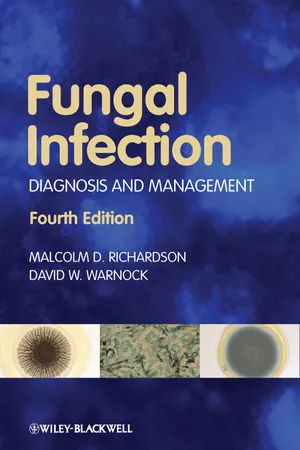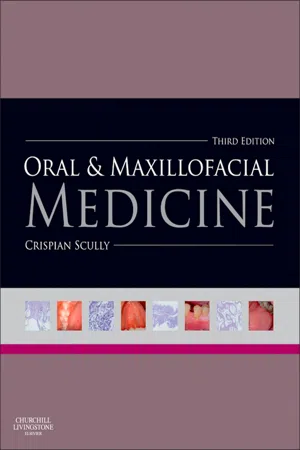Biological Sciences
Candidiasis
Candidiasis is a fungal infection caused by the overgrowth of Candida, a type of yeast. It commonly affects the skin, mouth, throat, and genital areas. Symptoms may include redness, itching, and discomfort, and treatment typically involves antifungal medications. In severe cases, candidiasis can lead to systemic infections, especially in individuals with weakened immune systems.
Written by Perlego with AI-assistance
Related key terms
3 Key excerpts on "Candidiasis"
- eBook - ePub
Fungal Infection
Diagnosis and Management
- Malcolm D. Richardson, David W. Warnock(Authors)
- 2012(Publication Date)
- Wiley-Blackwell(Publisher)
CHAPTER 5 Superficial candidosis 5.1 DefinitionThe term candidosis (Candidiasis) is used to refer to infections caused by yeasts belonging to the ascomycetous genus Candida . These opportunist pathogens can cause acute or chronic invasive infection in immunocompromised or debilitated individuals (see Chapter 11), but are more often seen causing mucosal, cutaneous or nail infection.5.2 Geographical distribution These conditions are worldwide in distribution. 5.3 The causal organisms and their habitatAlthough Candida albicans is the most important cause of superficial forms of candidosis, many other members of the genus are recognized as human pathogens. Most of these organisms are dimorphic, growing as budding yeast cells, pseudohyphae, and/or true hyphae. Typically, Candida glabrata (which used to be classified as Torulopsis glabrata ) produces only yeast cells, and only C. albicans forms true hyphae in tissues.Candida species can be recovered from the mouth and gastrointestinal tract of a substantial proportion (30–50%) of the normal adult population and from the genital tract of about 20% of normal women. C. albicans accounts for 60–80% of isolations from the mouth and 80–90% from the genital tract. C. albicans is seldom recovered from normal skin, being much less prevalent than Candida parapsilosis and Candida guilliermondii , but it is a frequent colonizer of moist or damaged skin and nails. Unlike C. albicans , Candida tropicalis , C. parapsilosis and a number of other pathogenic members of this large genus can sometimes be recovered from the environment.5.4 EpidemiologyIn most cases, superficial Candida - eBook - ePub
Oral and Maxillofacial Medicine
The Basis of Diagnosis and Treatment
- Crispian Scully(Author)
- 2012(Publication Date)
- Churchill Livingstone(Publisher)
The opportunistic pathogen grows either as yeasts or hyphae (i.e. it is a dimorphic fungus). Actual infection with Candida (usually Candida albicans) is common mainly in people who are otherwise unwell; candidosis is thus called a ‘disease of the diseased’. The importance of Candida has increased greatly, particularly as the HIV pandemic extends since, when host defences are compromised, Candida typically colonizes mucocutaneous surfaces and causes only superficial infections but in immunocompromised people candidosis is commonly oro-pharyngeal and can be a portal for entry into deeper tissues and invasive candidosis (see Chs 53 and 54). AETIOLOGY Host defences against Candida species include the following: Oral epithelium: a physical barrier. Microbial interactions: competition and inhibition by the oral flora. Salivary non-immune defences: mechanical cleansing plays a major role but other factors include salivary antimicrobial proteins (AMPs): lysozyme (muramidase): can damage Candida, stimulate phagocytosis and agglutinate Candida lactoferrin: is antifungal and antibacterial due to binding of iron or altering yeast cell wall permeability lactoperoxidase: is anticandidal via multiple factors (H 2 O 2 and halides) glycoproteins antigenically similar to blood group antigens – affect adherence to mucosa histatins antileukoprotease (secretory leukocyte protease; SLIP1) histidine-rich polypeptides calprotectin β-defensin 2. Oral immune defences, which include. mainly cell-mediated responses: T cells and phagocytes. The full expression of phagocyte effectiveness is dependent on augmentation by cytokines synthesized or induced by T cells, such as lymphokines and IFN-γ - Abraham J Domb, Konda Reddy Kunduru, Shady Farah(Authors)
- 2019(Publication Date)
- Royal Society of Chemistry(Publisher)
111.2 Discovery of Antifungal Drugs
The first antifungal agent reported was griseofulvin in 1939, then benzimidazole in 1944, followed by propamidine in 1945.7 –10The discovery of the first polyene macrolide antifungal, nystatin (NYS), in 1950 by Hazen and Brown, became a lead for the modern era of antifungal therapy.11 ,12In 1951, stilbamidine and its less toxic derivative, 2-hydroxystilbamidine were used in a few human cases of blastomycosis with limited success.13 ,14The discovery of amphotericin B (AmB) in 1955 and its advantages in comparison with existing antifungal drugs in the treatment of blastomycosis led to the development of more antifungal agents such as oral griseofulvin and topical chlormidazole in 1958, intravenous (iv ) AmB in 1960, 5-fluorocytosine in 1964, and miconazole and clotrimazole in 1969. The imidazole antifungals, with broad-spectrum activity against dermatophytes, Candida , and other infections were developed during the 1970s. Econazole for topical use, introduced in 1974, is still used. However, the systemic clotrimazole and miconazole introduced during that decade had limited success.15 –18Ketoconazole was the only oral agent available for the treatment of systemic fungal infections for a decade from 1981 and became the base in the search for new safer and effective agents. The significance of fluconazole was realized only in 1990, a decade after its discovery.10 Fluconazole, the first broad-spectrum triazole, overcame the shortcomings of the imidazoles—poor solubility and lack of an iv formulation—while itraconazole introduced in 1992 expanded the activity beyond Candida spp.19
Learn about this page
Index pages curate the most relevant extracts from our library of academic textbooks. They’ve been created using an in-house natural language model (NLM), each adding context and meaning to key research topics.


